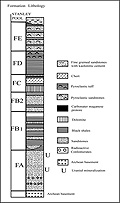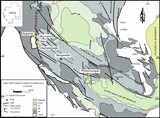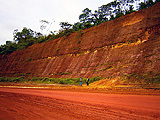Alexis Ndongo PhD thesis
 Sedimentological and tectonic setting of paleoproterozic Franceville basin (Gabon) : fluid pressure structures, bitumen and uranium deposits
Sedimentological and tectonic setting of paleoproterozic Franceville basin (Gabon) : fluid pressure structures, bitumen and uranium deposits
Defended on the 14th January 2016
Funding: Areva and Gabon government
Supervisors: Michel Guiraud, laboratoire Biogéosciences; Jean-Louis Feybesse, Areva NC Géoscience Groupe Technique
Started in November 2010
Abstract
Metallogenic deposits within paleproterozoic basins depend on generation and migration of fluids. The aim of this study is to provide a better understanding of tectonic, sedimentological and diagenetic setting of the uranium deposits in the Franceville basin and to characterize hydraulic fracturing impact on fluid migration processes in sandstone reservoirs.
Tectonic study define the N180-170° transfer faults, associated with Archean tectonic and the N110-120° longitudinal normal faults. These two fault directions split the Franceville basin into small sub-basins. The longitudinal normal faults are associated with footwall anticlines and hanging wall synclines. The uranium deposits of Franceville basin are located in footwall anticlines of longitudinal normal faults.
Sedimentological analysis allows to describe four depositional environments: Fluvial (lower FA), deltaic (middle FA), tidal (upper FA), and open marine environments (FB). Facies distribution in the FA-FB transition promotes the establishment of permeability barriers. These latter are responsible of the increase in fluid pressure and of the formation of fluid pressure structures (dykes, stylolites, quartz veins), in footwall anticlines of longitudinal normal faults. Increase in fluid pressure allows the migration of uranium-fluids, and hydrocarbon from the deep basin to the footwall anticline. Hydraulic fracturing processes lead the precipitation of uranium mineralization, associated with bitumen, in microfractures.
Keywords
Franceville basin, paleoproterozoic, transfer faults, longitudinal normal faults, footwall anticlines, permeability barriers, fluid pressure structures, hydraulic fracturing, bitumen, uranium mineralization
PhD commitee
Michel Mbina, université des sciences du Gabon
Michel Guiraud, laboratoire Biogéosciences
Roger Soliva, université de Montpellier 2
Emmanuelle Vennin, laboratoire Biogéosciences
- extrait:
- lien_externe:
- kc_data:
- a:8:{i:0;s:0:"";s:4:"mode";s:0:"";s:3:"css";s:0:"";s:9:"max_width";s:0:"";s:7:"classes";s:0:"";s:9:"thumbnail";s:0:"";s:9:"collapsed";s:0:"";s:9:"optimized";s:0:"";}
- kc_raw_content:
 Sedimentological and tectonic setting of paleoproterozic Franceville basin (Gabon) : fluid pressure structures, bitumen and uranium deposits
Sedimentological and tectonic setting of paleoproterozic Franceville basin (Gabon) : fluid pressure structures, bitumen and uranium depositsDefended on the 14th January 2016
Funding: Areva and Gabon government
Supervisors: Michel Guiraud, laboratoire Biogéosciences; Jean-Louis Feybesse, Areva NC Géoscience Groupe Technique
Started in November 2010
Abstract
[caption id="attachment_1236" align="alignnone" width="120"] Cliquer pour agrandir[/caption]
Cliquer pour agrandir[/caption]
Metallogenic deposits within paleproterozoic basins depend on generation and migration of fluids. The aim of this study is to provide a better understanding of tectonic, sedimentological and diagenetic setting of the uranium deposits in the Franceville basin and to characterize hydraulic fracturing impact on fluid migration processes in sandstone reservoirs.
Tectonic study define the N180-170° transfer faults, associated with Archean tectonic and the N110-120° longitudinal normal faults. These two fault directions split the Franceville basin into small sub-basins. The longitudinal normal faults are associated with footwall anticlines and hanging wall synclines. The uranium deposits of Franceville basin are located in footwall anticlines of longitudinal normal faults.
[caption id="attachment_1238" align="alignnone" width="160"] Cliquer pour agrandir[/caption]
Cliquer pour agrandir[/caption]
Sedimentological analysis allows to describe four depositional environments: Fluvial (lower FA), deltaic (middle FA), tidal (upper FA), and open marine environments (FB). Facies distribution in the FA-FB transition promotes the establishment of permeability barriers. These latter are responsible of the increase in fluid pressure and of the formation of fluid pressure structures (dykes, stylolites, quartz veins), in footwall anticlines of longitudinal normal faults. Increase in fluid pressure allows the migration of uranium-fluids, and hydrocarbon from the deep basin to the footwall anticline. Hydraulic fracturing processes lead the precipitation of uranium mineralization, associated with bitumen, in microfractures.
[caption id="attachment_1240" align="alignnone" width="160"] Cliquer pour agrandir[/caption]
Cliquer pour agrandir[/caption]
Keywords
Franceville basin, paleoproterozoic, transfer faults, longitudinal normal faults, footwall anticlines, permeability barriers, fluid pressure structures, hydraulic fracturing, bitumen, uranium mineralization
PhD commitee
Michel Mbina, université des sciences du Gabon
Michel Guiraud, laboratoire Biogéosciences
Roger Soliva, université de Montpellier 2
Emmanuelle Vennin, laboratoire Biogéosciences
